|

On this page you'll find the short
cut rules. They are meant to make it as easy as possible
to start playing the tournament version of GIPF without having to
go through the basic and standard rules. After all, the tournament
version concerns "the real game"! There are lots of diagrams, but
don't expect to find an explanation of every single detail. Our
aim is to get you playing in no time - and if you would have further
questions, we advise…
1. either to have a close look at the complete
rules (covering the basic, standard and tournament versions),
as they were printed and enclosed in the GIPF-box,
2. or to go to the page with Frequently
Asked Questions,
3. or to play GF1,
a very good GIPF-program (you can get it for free on this site;
once you have it, you'll be able to find out all you need to know
while playing the game),
4. or to send us an e-mail
with your questions.
Rules in other languages:
Italian,
by Massimo Colamesta
Swedish,
by Roland "Rolle" Johansson

Aim
The first player to create a situation where his opponent either
has no more pieces in his reserve or no more GIPF-pieces on the
board, wins the game. So, keep in mind: make sure to always have
at least one piece in reserve and always at least one GIPF-piece
on the board.
Pieces
The players start with 18 pieces in reserve each. Pieces in reserve
are pieces of your own color that are not in play. A GIPF-piece
is 2 pieces stacked one upon another.
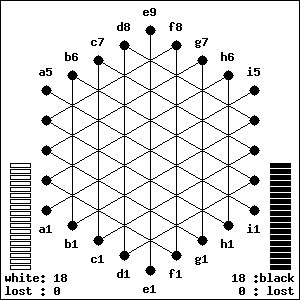 The
board The
board
There are 24 dots at the edges of the pattern on the board. Dots
are not part of the play area;
they serve to position a piece before bringing it into play. The
play area is made up of 37 spots (intersections). Only the pieces
covering a spot are part of the game. The lines indicate in which
directions pieces may be moved.
The start
The board is empty. Both players have 18 pieces in reserve.
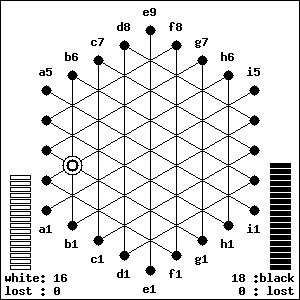 First
move: GIPF-piece First
move: GIPF-piece
Draw lots for your color. If you draw white, you begin. Your first
move must be a GIPF-piece. Take two pieces out of your reserve
and stack them on top of each other; put the double piece on any
of the black dots and next push it onto an adjacent spot. You may
move a piece only one spot at a time, never two or more. Then your
opponent brings a GIPF-piece into play.
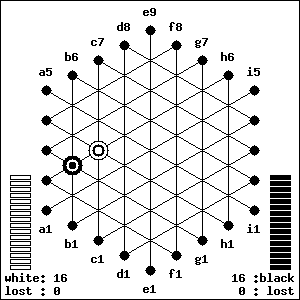 Moving
other pieces Moving
other pieces
Both players have made one move. When introducing a piece you
can either move it to an empty spot, or to an already occupied spot.
If the spot is already occupied, it must first be cleared: the piece
occupying it, regardless of its color, must be moved to the next
spot on the line (if that spot would also be occupied, then this
piece also moves over one spot, etc.). Next, push the piece onto
the cleared spot. In the diagram Black moved over the white GIPF-piece
one spot.
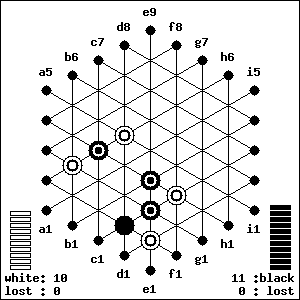 Introducing
single pieces Introducing
single pieces
Both players may introduce as many GIPF-pieces as they want, until
they bring a single piece into play. When learning the game, we
advise you to play with 3 or 4 GIPF-pieces. In the diagram Black
just played a single piece (on spot d2) and may introduce no more
GIPF-pieces during the rest of the game. White may still do so until
he, too, plays his first single piece.
Two restrictions:
1. A piece already in play may not be moved as a separate piece.
A piece (or more pieces) on the board can only be moved by introducing
a new piece. All of the pieces in play may be pushed by both players,
black and white pieces, single and GIPF-pieces.
2. When all the spots on a line are occupied, you cannot play in
the direction of that line. If you would, you would push a piece
out of the game at the opposite site and that is not allowed.
Recycling and capturing pieces
Very simple: as soon as 4 single pieces of your color are lined
up on adjacent spots (dots don't count!), it is compulsory to take
them from the board. Moreover, not only must these 4 pieces be removed,
but also the pieces that form a direct extension of them. The pieces
of your own color are returned to your reserve, the pieces of the
other color are captured, thus lost to your opponent. (See diagrams
below)
GIPF-pieces in play
A GIPF-piece counts for just one piece. The only difference between
a single piece and a GIPF-piece (no matter the color) it that GIPF-pieces
may be left on the board when they are part of a row that must be
removed. If you remove a GIPF-piece of your color, you may not introduce
it as a GIPF-piece any more if you already started playing with
single pieces: you must split the GIPF-piece into two single pieces.
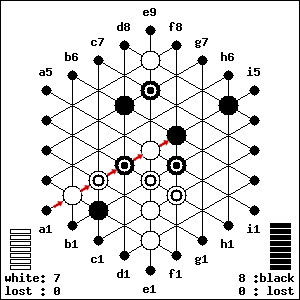 Diagram: White played a1-f5 (indicated with the arrow). By doing
so, he pushed a white piece onto the central spot and formed himself
a row of 4 pieces on the e-diagonal. He must remove the 3 single
pieces and may chose what to do with the GIPF-piece, i.e. remove
it or leave it on its spot. The 2 pieces at the other end of the
diagonal remain on the board, because they don't extend the row
of 4 without interruption.
Diagram: White played a1-f5 (indicated with the arrow). By doing
so, he pushed a white piece onto the central spot and formed himself
a row of 4 pieces on the e-diagonal. He must remove the 3 single
pieces and may chose what to do with the GIPF-piece, i.e. remove
it or leave it on its spot. The 2 pieces at the other end of the
diagonal remain on the board, because they don't extend the row
of 4 without interruption.
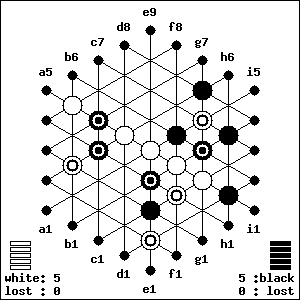 In the diagram you see a row of 4 white pieces on the a5-i1 diagonal.
White must remove the 4 pieces in a row AND the white and black
single piece extending the row AND, if wanted, the Black GIPF-piece…
which results in the situation in the next diagram…
In the diagram you see a row of 4 white pieces on the a5-i1 diagonal.
White must remove the 4 pieces in a row AND the white and black
single piece extending the row AND, if wanted, the Black GIPF-piece…
which results in the situation in the next diagram…
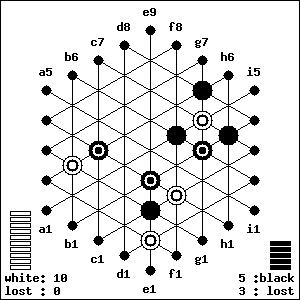 White took the Black-GIPF-piece on c5, of course. It rarely happens
that it is better to leave an opponent's GIPF-piece on the board.
In total White captured 3 black pieces and recycled 5 white pieces.
So, as you see, each time a player forms a row, quite a few pieces
are to be removed. As such, GIPF is played in waves: you put pieces
on the board, trying to get in a position that will allow you to
capture something, and if you do so, you must start building again…
White took the Black-GIPF-piece on c5, of course. It rarely happens
that it is better to leave an opponent's GIPF-piece on the board.
In total White captured 3 black pieces and recycled 5 white pieces.
So, as you see, each time a player forms a row, quite a few pieces
are to be removed. As such, GIPF is played in waves: you put pieces
on the board, trying to get in a position that will allow you to
capture something, and if you do so, you must start building again…
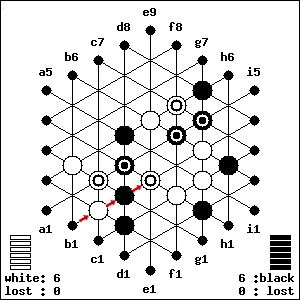 Forced capture
Forced capture
Taking pieces from the board is not a move in itself; it is always
the result of a move, either your move, or your opponent's. In the
diagram white played b1-e4 and completed a row of 4 black pieces.
Black must take the 3 single pieces from the board, and decide what
he'll do with the GIPF-piece, and must then make a move. Now Black
has more pieces in reserve, but White's advantage is that Black
has less pieces on the board, thus a weaker position!
Note: if one or two pieces would extend the row (no matter what
color), Black must take them, too.
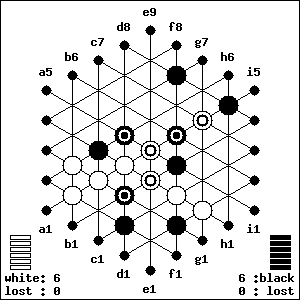 2
rows… 2
rows…
It may occur that two rows are lined up at the same time. If these
rows don't intersect, both must be removed. If they do intersect
(as shown in the diagram), the player may choose which row he will
take. (If there would be a GIPF-piece on the spot of intersection,
White may first take one row, leave the GIPF-piece and the board,
and next take the second row.)
 When a situation occurs in which both players must remove pieces,
the player who caused the situation goes first.
When a situation occurs in which both players must remove pieces,
the player who caused the situation goes first.
In the diagram: White has made the move indicated by the arrow and
may take pieces first; he takes 4 white pieces and captures a GIPF-piece.
Next Black must remove the row of 4 black pieces - and captures
nothing.
 Row
of 4 GIPF-pieces Row
of 4 GIPF-pieces
It may happen that 4 (or even more) GIPF-pieces of one color are
lined up. In this case, you may leave them on their spots or you
may take one or more from the board. If you decide to leave them
on the board and they are still lined up when it is your turn again,
then you may again choose what you'll do before you make your move,
and, if they are still lined up after having played, after your
move.
 End
of a game End
of a game
There are two ways of winning: you must capture your opponent's
last GIPF-piece or you must exhaust his reserve. As said in the
beginning: a player who has either no more GIPF-pieces on the board,
or has no more pieces left to make a move, loses the game.
In the diagram: White captures Black's last GIPF-piece and wins…
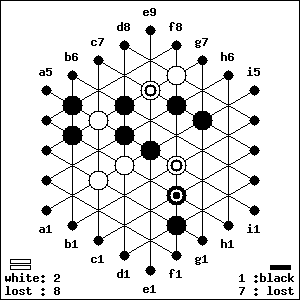 Diagram: it is Black's turn. He has only one piece left in his reserve
and there's no way to recycle pieces. So, he'll run out of pieces
and lose with his next turn. (Note that White lost more pieces than
Black, yet still wins!)
Diagram: it is Black's turn. He has only one piece left in his reserve
and there's no way to recycle pieces. So, he'll run out of pieces
and lose with his next turn. (Note that White lost more pieces than
Black, yet still wins!)
Remarks
1. Don't misinterpret the aim of the game; you can only win by capturing
the opponent's pieces, not by returning your own pieces repeatedly
from the board to the reserve!
2. A tie is not possible. The first player to run out of pieces
loses the game, even if the other player, too, would run out of
pieces in his next turn.
3. Players should always be able to see how many pieces the opponent
has left in his reserve. Leave them clearly visible next to the
board.
|




 Diagram: White played a1-f5 (indicated with the arrow). By doing
so, he pushed a white piece onto the central spot and formed himself
a row of 4 pieces on the e-diagonal. He must remove the 3 single
pieces and may chose what to do with the GIPF-piece, i.e. remove
it or leave it on its spot. The 2 pieces at the other end of the
diagonal remain on the board, because they don't extend the row
of 4 without interruption.
Diagram: White played a1-f5 (indicated with the arrow). By doing
so, he pushed a white piece onto the central spot and formed himself
a row of 4 pieces on the e-diagonal. He must remove the 3 single
pieces and may chose what to do with the GIPF-piece, i.e. remove
it or leave it on its spot. The 2 pieces at the other end of the
diagonal remain on the board, because they don't extend the row
of 4 without interruption.  In the diagram you see a row of 4 white pieces on the a5-i1 diagonal.
White must remove the 4 pieces in a row AND the white and black
single piece extending the row AND, if wanted, the Black GIPF-piece…
which results in the situation in the next diagram…
In the diagram you see a row of 4 white pieces on the a5-i1 diagonal.
White must remove the 4 pieces in a row AND the white and black
single piece extending the row AND, if wanted, the Black GIPF-piece…
which results in the situation in the next diagram… White took the Black-GIPF-piece on c5, of course. It rarely happens
that it is better to leave an opponent's GIPF-piece on the board.
In total White captured 3 black pieces and recycled 5 white pieces.
So, as you see, each time a player forms a row, quite a few pieces
are to be removed. As such, GIPF is played in waves: you put pieces
on the board, trying to get in a position that will allow you to
capture something, and if you do so, you must start building again…
White took the Black-GIPF-piece on c5, of course. It rarely happens
that it is better to leave an opponent's GIPF-piece on the board.
In total White captured 3 black pieces and recycled 5 white pieces.
So, as you see, each time a player forms a row, quite a few pieces
are to be removed. As such, GIPF is played in waves: you put pieces
on the board, trying to get in a position that will allow you to
capture something, and if you do so, you must start building again…


 When a situation occurs in which both players must remove pieces,
the player who caused the situation goes first.
When a situation occurs in which both players must remove pieces,
the player who caused the situation goes first. 

 Diagram: it is Black's turn. He has only one piece left in his reserve
and there's no way to recycle pieces. So, he'll run out of pieces
and lose with his next turn. (Note that White lost more pieces than
Black, yet still wins!)
Diagram: it is Black's turn. He has only one piece left in his reserve
and there's no way to recycle pieces. So, he'll run out of pieces
and lose with his next turn. (Note that White lost more pieces than
Black, yet still wins!)